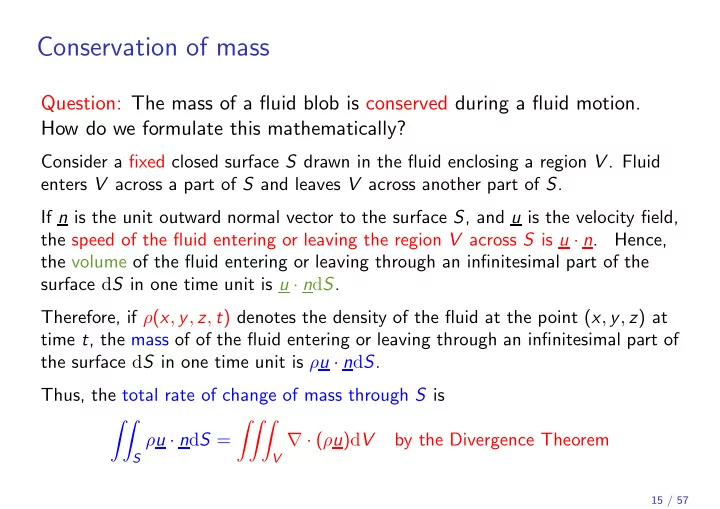

Conservation of mass Question: The mass of a fluid blob is conserved during a fluid motion. How do we formulate this mathematically? Consider a fixed closed surface S drawn in the fluid enclosing a region V . Fluid enters V across a part of S and leaves V across another part of S . If n is the unit outward normal vector to the surface S , and u is the velocity field, the speed of the fluid entering or leaving the region V across S is u · n . Hence, the volume of the fluid entering or leaving through an infinitesimal part of the surface d S in one time unit is u · n d S . Therefore, if ρ ( x , y , z , t ) denotes the density of the fluid at the point ( x , y , z ) at time t , the mass of of the fluid entering or leaving through an infinitesimal part of the surface d S in one time unit is ρ u · n d S . Thus, the total rate of change of mass through S is �� ��� ρ u · n d S = ∇ · ( ρ u ) d V by the Divergence Theorem S V 15 / 57
Conservation of mass On the other hand, the mass of the fluid in V is ��� ρ d V V and, hence the rate of change of mass inside V is ∂ ∂ρ ��� ��� ρ d V = ∂ t d V ∂ t V V as V is fixed. But, conservation of mass yields that the rate of change of mass of the fluid inside V is minus the total rate of change of mass passing through S ; hence ∂ρ ��� ��� ∂ t d V = − ∇ · ( ρ u ) d V V V or ∂ρ ��� ∂ t + ∇ · ( ρ u ) d V = 0 V 16 / 57
Conservation of mass But the volume V is arbitrary; hence ∂ρ ��� ∂ t + ∇ · ( ρ u ) d V = 0 V yields ∂ρ ∂ t + ∇ · ( ρ u ) = 0 . This is the, so called, conservation of mass equation. 17 / 57
Modelling Assumptions We shall make some assumptions on the behaviour of the fluid, where most of our discussion will be based on. Modelling Assumptions: ◮ The fluid is incompressible, that is, any fluid element does not change volume. ◮ The density ρ of the fluid is constant, that is, it the same for all fluid elements. ◮ The force exerted across a geometrical surface element n d s within the fluid is pn d s where p ( x , y , z , t ) is a scalar function, independent of the normal n , called the pressure. BIG IDEA: A fluid element can apply force to another only on the normal direction! We shall also investigate later what happens when each of these assumptions is dropped. 18 / 57
Modelling Assumptions Are the modelling assumptions realistic? ◮ Incompressibility. For many “usual” liquids (water, oil etc.) this is realistic in many situations of practical interest. Also for some slow gas flows (e.g., air) it is assumed in practice. ◮ Constant density. When the flow is incompressible this is realistic in many situations of practical interest. ◮ Fluid element interactions only the normal direction. Such a fluid is called inviscid. It means that there is no tangential component in the force exerted by each fluid element. This is not realistic for almost all fluids, but it is a very good approximation to reality for many fluids in slow flows. If the fluid is very viscous (e.g., honey, syrup) then it is not realistic. 19 / 57
Incompressibility We want to formulate incompressibility mathematically. Incompressibility means, that the volume of a fluid blob remains constant throughout the flow, i.e., constant with respect to time. As the mass is conserved, this yields that the density is also constant with respect to time. Hence ∂ρ ∂ t = 0 . Conservation of mass equation then gives ∇ · ( ρ u ) = 0 . Using the second modelling assumption (constant density throughout the fluid) we obtain ρ ∇ · u = 0 and thus ∇ · u = 0 20 / 57
Incompressibility We, therefore, conclude that: A fluid is incompressible if and only if ∇ · u = 0 Remark: Recall the definition of an incompressible vector field from the past ... It is the same! Hence the terminology is now explained. 21 / 57
Recommend
More recommend